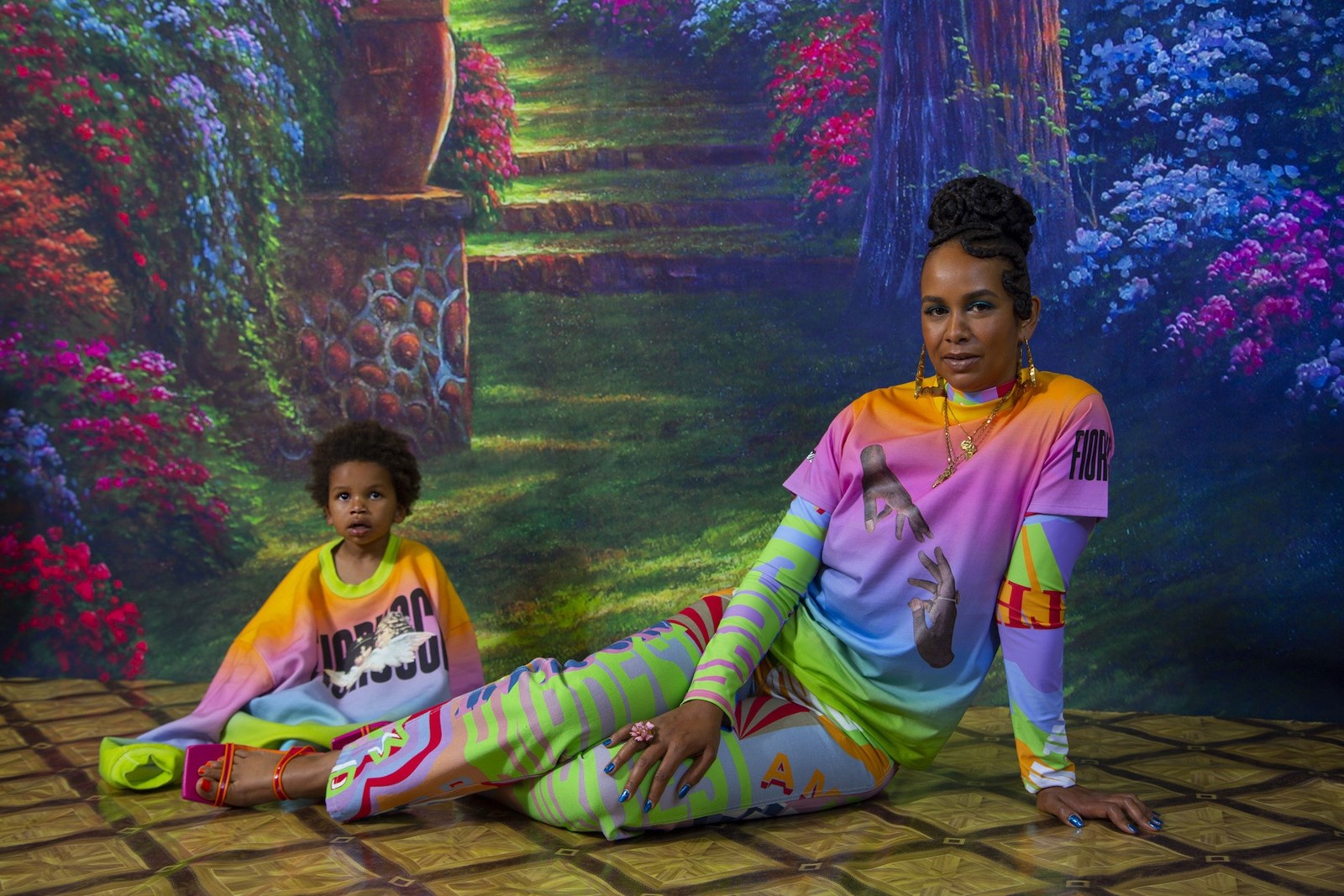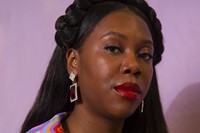Fiorucci has a long history of working with artists. In the 80s, founder Elio Fiorucci invited Keith Haring to collaborate – the artist, with the help of his 16-year-old protégé Angel Ortiz AKA LA II, spray-painted the walls of the first Fiorucci store in Milan’s Galleria Passarella.
It was in this same spirit that the incumbent creative director of the label, Daniel Fletcher, invited Lakwena Maciver to team up on a capsule collection. Based in London, Lakwena is known for her large-scale paintings employing bright colour and bold text, which often appear in public spaces in the form of murals. These murals, which Lakwena says can be understood as “escape routes, afrofuturistic portals to utopia” are, in some ways, reminiscent of Fiorucci’s stores, which have historically been filled with brightly-coloured objects.
The starting point for this collection began with a visit to Fiorucci’s archive, where Lakwena learned about the brand’s connection to disco; to people dancing, celebrating and having a good time. And while that moment cannot be recreated, it’s this energy that she wanted to channel into the collection. Through further research, she identified more crossovers between Fiorucci and her work; between Fiorucci’s relationship with disco and her own relationship with gospel – a musical culture that is similarly centred around ideas of connectedness, spirituality and joy.
The resulting collection melds Fiorucci’s visual language with that of Lakwena, combining kaleidoscopic colours, reworked logos and original motifs. Taking cues from another musical culture, UK garage, the collection features all-over print denim jacket and jeans, shirts and velvet flares, along with Lycra tops emblazoned with Fiorucci’s iconic Angels motif. A satin colour-block bomber is accompanied by hoodies, sweatshirts, T-shirts, trousers and shorts, featuring a Fiorucci logo and an original hand motif by Lakwena, in a gesture of prayer or praise.
Lakwena’s collaboration with Fiorucci is presented via images and a film created by Ruth Ossai, starring a gospel choir who, diverse in age and size, encapsulate this idea of coming together and deliver an uplifting message of connectedness and joy – perhaps in a time when we need it the most. Here, in a conversation taken from a limited edition zine celebrated the collection published by D’Stassi Art, the artist delves into this collection and its inspirations.
Ted Stansfield: Can you introduce yourself and your artistic practice?
Lakwena Maciver: I’m an artist based in Dalston, London. My work tends to be very large-scale. I do murals and installations. It’s very colourful and I use a lot of text – that’s really key.
TS: And can you tell me about your name and how it relates to your practice?
LM: My name means ‘messenger’ in Acholi, which is my father’s language. And my work is very much about messages. It’s about speech and speaking truth and hope into spaces.
TS: What kind of messages are you wanting to communicate?
LM: A lot of the messages are positive, but it’s not really about positivity. I think it’s partly that I am naturally a bit pessimistic, and life is difficult. So in a way, I’m speaking these messages to myself. But I’m also speaking to others. I’m trying to speak truth into life.
TS: What does Fiorucci represent to you?
LM: I was really interested in Fiorucci’s history of collaboration and community; creative community. From what I’ve read, and what I’ve heard, there was this incredible moment in the 70s and 80s, when people were coming together and something really creative was emerging, in a very organic way. I found that really exciting.

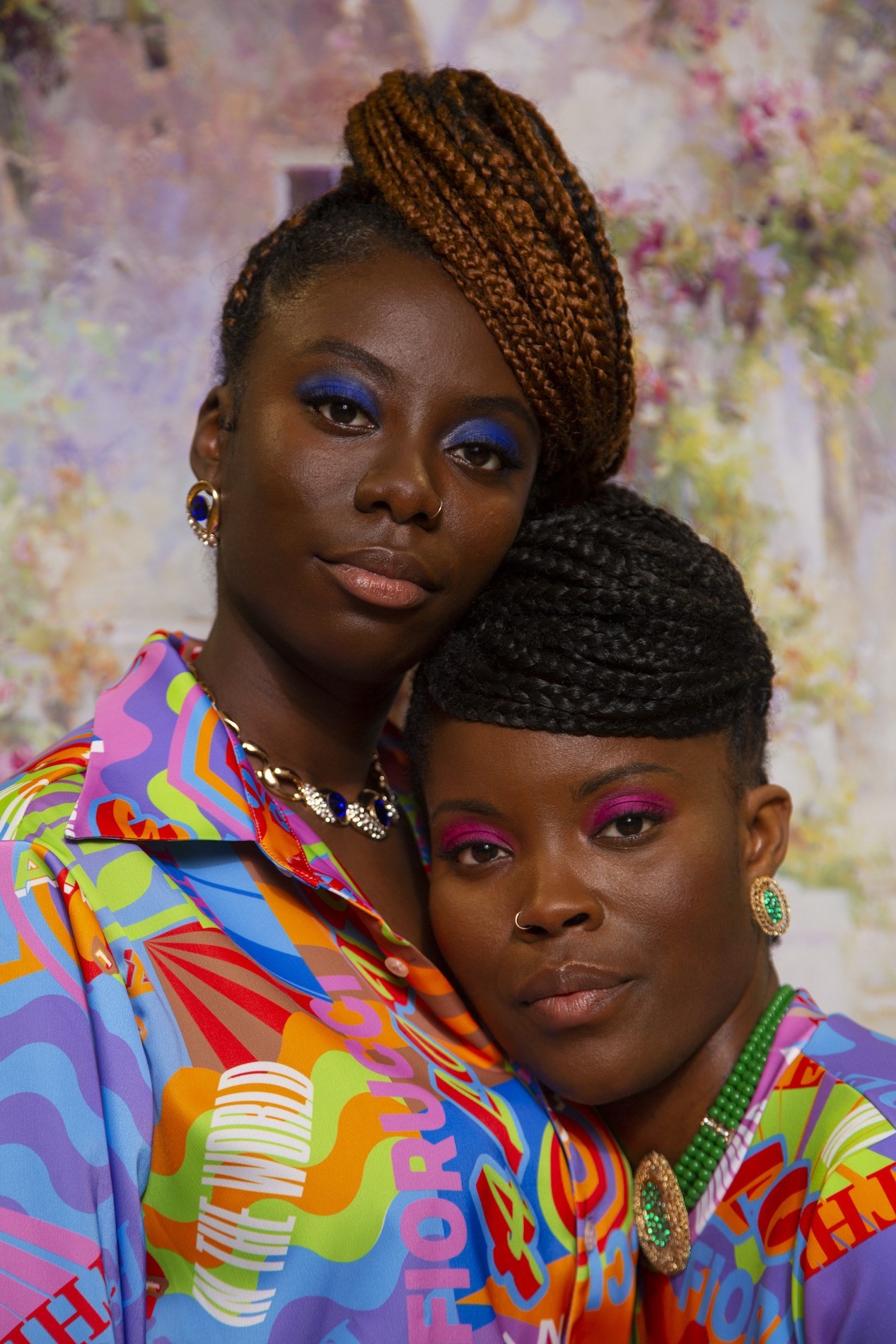
TS: Because Fiorucci actually has its own history of collaborating with artists. You know, they worked with Keith Haring. How did it feel to be stepping into that legacy?
LM: It’s amazing that Fiorucci collaborated with people like Keith and Madonna. And it’s really nice, actually, because when I was in New York, I painted the Bowery Wall, which is a really iconic wall in New York, that was first painted by Keith. Doing this collaboration is like another way of connecting with that.
TS: It’s interesting that Keith did graffiti art and you do wall murals.
LM: Yeah. He studied fine art, but made loads of work in public spaces. He straddled the worlds of fine art and street art, and did so in a really powerful way. I think he’s amazing. And I love the idea.
TS: In terms of this collaboration, have you thought about the relationship between art in public spaces and then on people, through clothes?
LM: Yeah, I love that. Because my vision for my work is that it isn’t just in galleries. So for me, making work in public spaces, it’s accessible, it’s large-scale, it can be really immersive, and it connects with people who wouldn’t normally walk into a gallery. I want to make work that speaks to ordinary people and speaks to lots of different types of people, so that’s why I like making work in public spaces. And in terms of fashion, I think fashion is another really interesting way that our culture connects with images, that everyday people connect with visual culture. We all wear clothes, we all have to wear clothes, so what do we adorn ourselves with? What do we put on? So the idea that I’m now, by this collaboration, making images that people are going to be wearing, in public spaces. I think it is really interesting.
TS: So how did you approach the collaboration? What was your starting point?
LM: I started by looking through the book [Fiorucci: Tyes and Tribes], because I wanted to understand a bit about Fiorucci and its history. From what I learned, it was very much about community – the clothes were almost secondary, the primary thing seems to have been about people and this organic creativity; people who were involved in music, art, the whole thing together. I was thinking about how disco was central to Fiorucci and how the gospel is central to my work. Because there’s a really interesting crossover between gospel and disco.
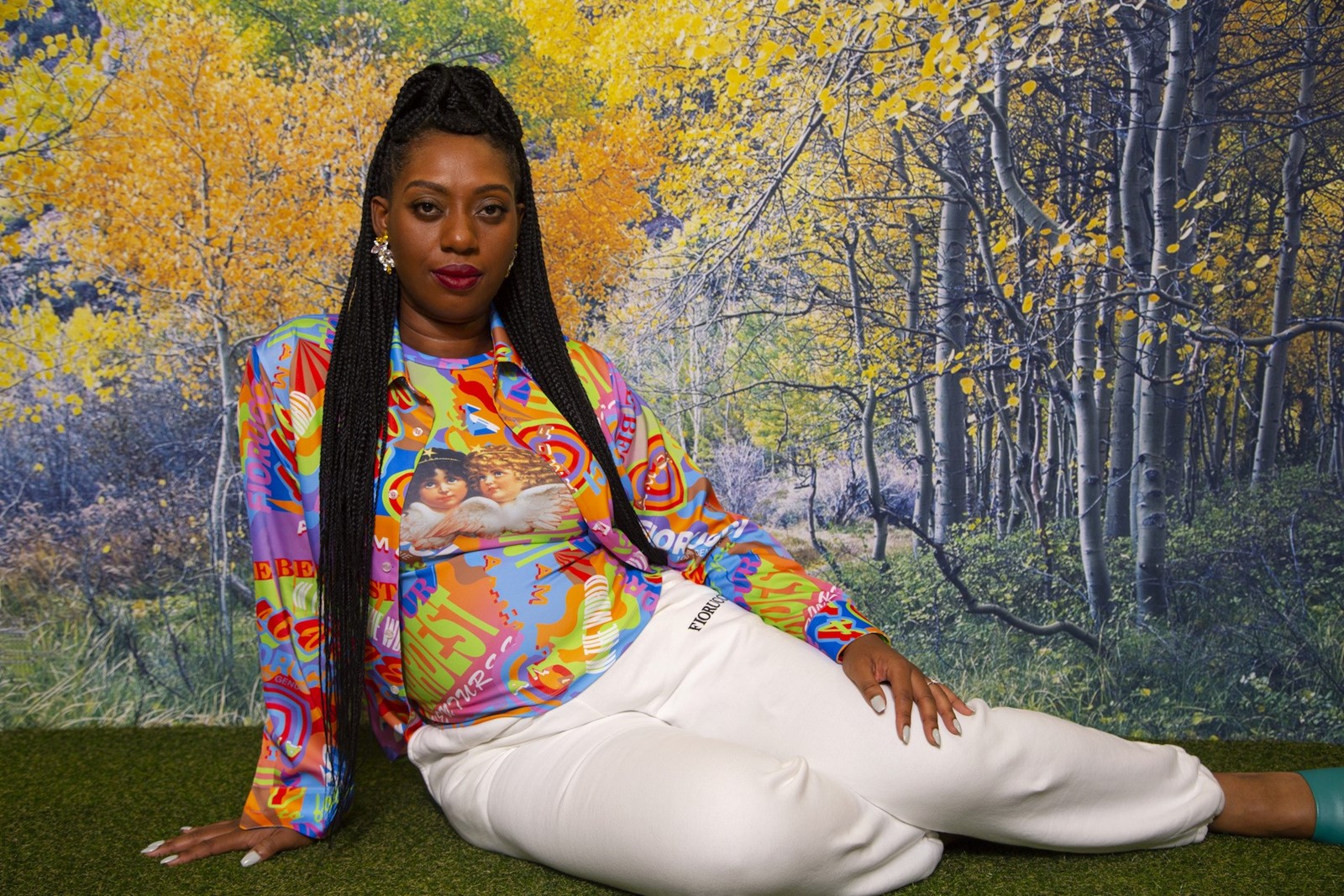
TS: So let’s talk about that crossover. Disco is about people coming together – Black, white, gay, straight – and celebrating.
LM: Yeah, congregating.
TS: What are the similarities that struck you?
LM: It’s that thing of people coming together, which is really powerful, isn’t it? Coming together to celebrate, coming together to escape, and coming together regularly, so that it becomes part of your life. You live it. But also, my work explores this yearning for paradise and even the word ‘paradise’. I mean that crops up so much in disco, doesn’t it? Interestingly, it doesn’t crop up so much in gospel, but it pops up loads in the scriptures, and the concept of heaven is all over the music. So this yearning for paradise, utopia, heaven, all of these types of words, really link these two genres. That’s what I was interested in.
TS: And is your work about sort of longing for paradise here, too? Like, redemption?
LM: Yeah, it’s not just waiting. It’s the now and not yet.
TS: Can you tell me about the original motifs you created for the collection?
LM: I’m really interested in typography – words, but also how they look. So I went through Fiorucci’s digital archive and found all of these words like heaven and paradise, which resonate with me but were also really infused in Fiorucci’s story. And I picked them out and I started to draw them, embellish them and play around with them, and I made this big print, which brought all of that together.
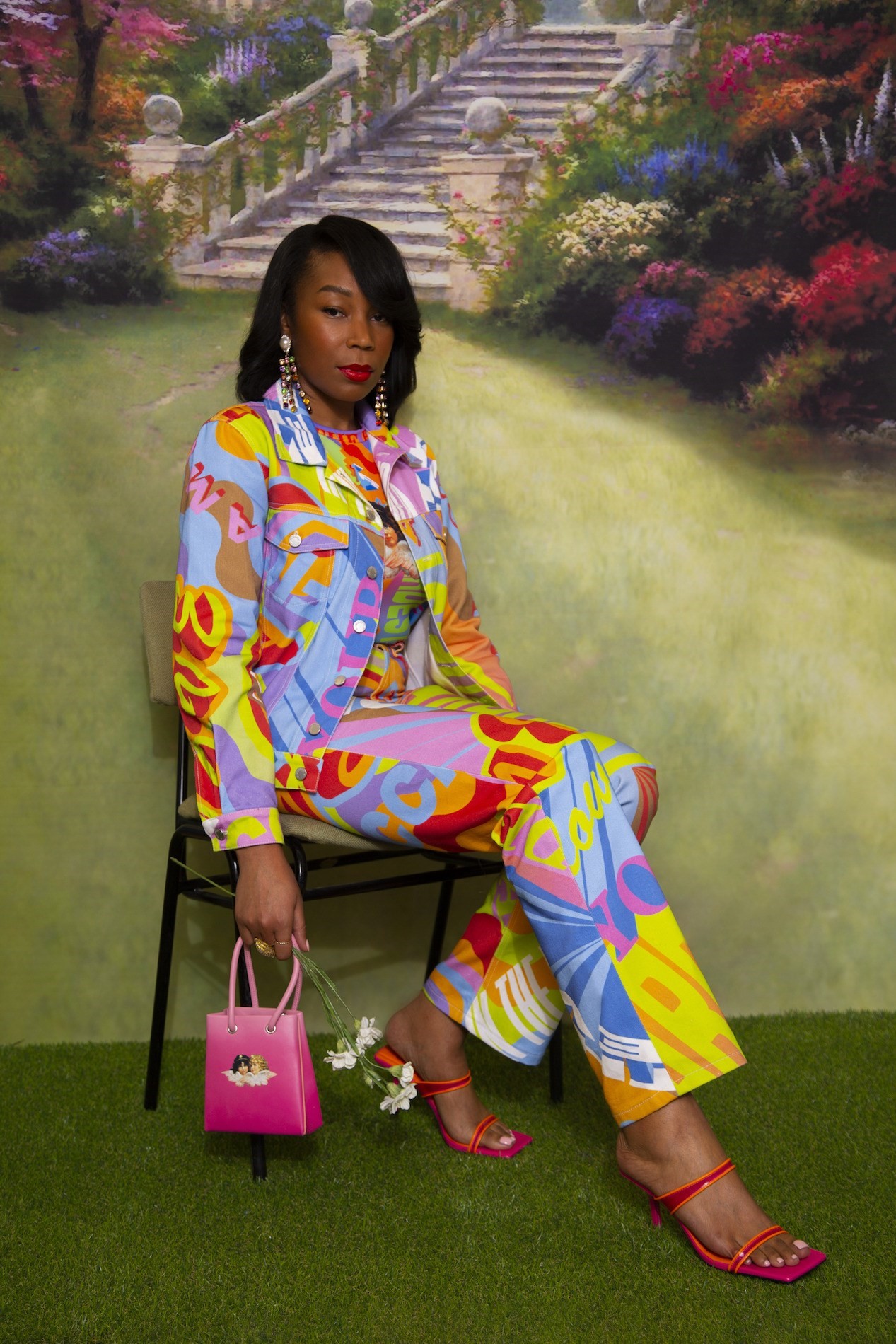

TS: And then you created a film with Ruth Ossai and Theo White.
LM: So I thought about having a gospel choir involved in the project, as that would be a way of bringing people into it, because I thought that was really important. I could do some really interesting artwork, and put it on some clothes, but what was really important was bringing people into it, because community is so key to Fiorucci. So that’s kind of where I started my thinking. A friend of mine, Ruth Ossai, agreed to film it and another friend, Theo White, styled it. And we haven’t worked together before, but it was so much fun. It just felt really natural, really organic.
I didn’t want some corporate choir, I wanted a choir who had formed organically and who were about community. 15 years ago, my sister Abimaro was in a choir with some friends when they were at college. And they used to do church events – conventions, as we called them – in rundown community halls, very low-key but so much fun. And I knew that they would bring the energy that I wanted to express.
There was a real vibe. I was in and out of the room, but while the girls were having their hair and make-up done, they were warming up and it was just beautiful. This was the first time that they’d got back together in 15 years and, you know, they were teenagers then and now they’re grown women with completely different lives. But they remembered all their songs and the singing was beautiful. People were in tears listening to it. It was beautiful.
And the community hall was really nice, because the space that we found to shoot was a space that me and my sister had both been involved in. I used to take my kids there for playgroups and she has done workshops with young people and old people in the local community there, so it just felt really natural, really organic, exactly what we wanted.
TS: Where is this community hall?
LM: It’s east London. We really wanted to find a place in south London because that was just so much the essence of the thing, but this was very similar in aesthetic – the muted pink and yellow, and mint green walls, everything patched together and the dingy light which is a bit grimy but also feels homey in a weird way. And it doesn’t feel showy, it just feels natural.
TS: At fashion month, a lot of designers were exploring ideas of freedom and escapism, and offering an antidote to the pessimism that’s everywhere. That feels quite relevant to this collaboration in a way. How do you feel about that, and what do you want people to take away from this collection?
We’ve been working on this for quite a long time, in the midst of lockdown and all of that, so that’s definitely part of the story. We’ve been kept away from each other and gospel and disco are very much about being with each other. And not just being together but celebrating. I hope people get that feeling from the clothes, that they are about having fun.
TS: So how would you describe the spirit of the collection?
LM: I’d probably describe the spirit of the collection as celebrating life together.
Fiorucci x Lakwena is available to shop via fiorucci.com. J.O.Y. is published by D’Stassi Art, and is out now.
Artwork: Lakwena Maciver. Artistic direction: Daniel Fletcher. Photography Ruth Ossai. Photography: Robert David Foster. Styling: Theo White. Production: Alix Murat. Hair: Shamara Roper. Make-up: Joey Choy. Art direction and production: Ben Ditto. Graphic design: Ricardo Gonçalves. Soul Sound Choir: Abimaro Gunnell, Shivon Oduro-Kwateng, Rebekah Parkes, Sandra Townsend, Evelyn Van-Beest, Juliana Ogunjinmi Bamidele, Emmanuel Ogunjinmi and Lisa Okoroafor. Lakwena’s family: Mark Maciver, Makelo Maciver and Aroko Maciver
